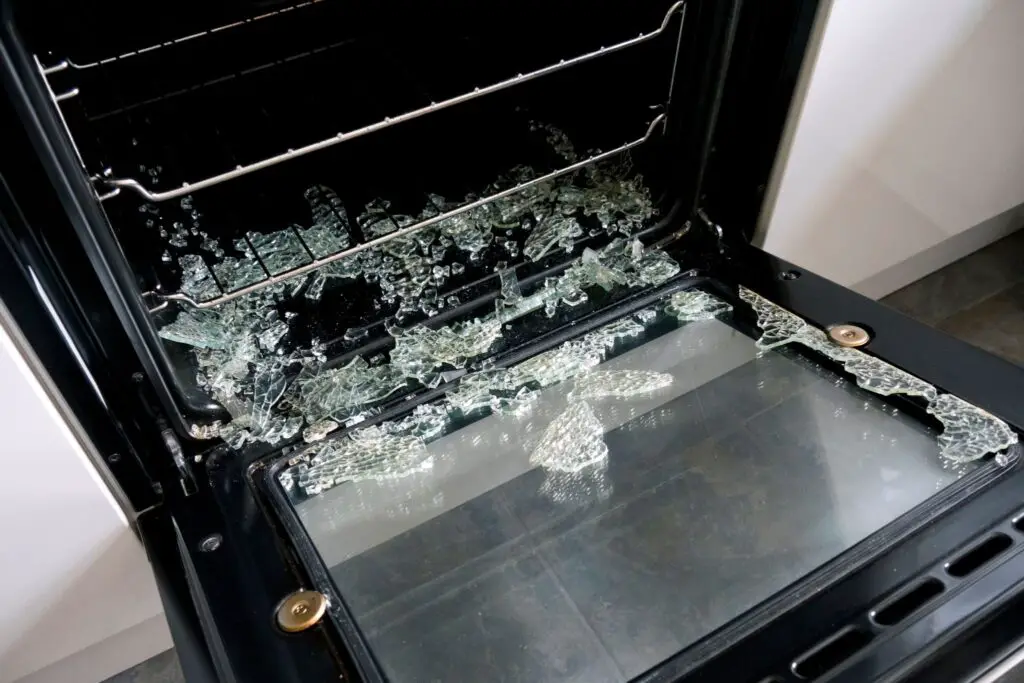Originally Created on: June 12, 2023 @ 10:08 am
Can you put tempered glass in the oven? Tempered glass has unique properties that make it more heat resistant and durable, but exposure to the oven’s heating elements still poses a risk.
Unlike standard glass that breaks into sharp and dangerous shards, tempered glass fractures into smaller, safer, blunt pieces.
The extra strength makes tempered glass useful for applications like oven doors, tabletops, and shower doors that require increased impact resistance. However, even tempered glass has its limits.
You May Also Like: How Do You Put Out A Fire In Your Oven? [The ULTIMATE Guide +4 Tips]
Table of Content
Can You Put Tempered Glass In The Oven?
Tempered glass is designed to withstand high levels of impact but cannot withstand the high temperatures found in conventional ovens.
Here are the main reasons why tempered glass should not be put in the oven:
Tempered glass has a unique chemical and heating treatment that gives it impact resistance and strength.
Subjecting it to the high temperatures of an oven, usually over 300 degrees Fahrenheit, can reverse this tempering process and weaken the glass. Once tempered glass loses its temper, it becomes much more brittle and susceptible to breaking.
The extreme temperature changes involved with baking and removing dishes from the oven can also cause sudden and uneven expansion and contraction of the tempered glass.
These thermal shocks and stresses can lead to fracturing or shattering of the tempered glass.
Most oven racks and shelves are metal, which conducts heat faster than glass.
When placing tempered glass directly on hot metal racks or shelves, localized hot spots can develop quickly on the glass, again causing uneven heating and increasing the risk of thermal shock and breakage.
Can Tempered Glass Be Heated?

Tempered glass can be heated to an extent, although there are limits to how hot it can become. Tempered glass is stronger and more resistant to breakage than regular glass because it has been heat-treated during manufacturing.
Tempered glass undergoes a heating and cooling process that puts the outer surfaces into a state of compression while putting the inner core into a state of tension. This increases the resistance to pressure and impact.
However, overheating tempered glass can disrupt this fragile balance and cause it to fracture or explode.
The tempered glass starts to weaken at temperatures above 400 degrees Fahrenheit and can break if heated above 500 degrees Fahrenheit.
While it can withstand some heat exposure, tempered glass should generally be avoided in applications where it will be directly and continuously exposed to high temperatures.
You May Also Like: When Is The Perfect Time To Take Cookies Out Of The Oven? [The EPIC Answer]
Surges of heat from fireplaces, ovens, or other sources should also be avoided. Tempered glass is best suited for applications where it will experience relatively moderate and stable temperatures.
Can You Put A Tempered Glass Lid In The Oven?

While tempered glass may seem like a durable surface, putting a tempered glass lid in the oven is typically not advised. Tempered glass is strong against impact and pressure, but heat exposure can cause damage.
Tempered glass lids are made to withstand higher temperatures when used on countertops or stovetops. However, baking temperatures in ovens of 350 to 425 degrees Fahrenheit can exceed what the glass is designed for.
At those high temperatures, the glass lid may warp, crack or even shatter from the heat stress. The extreme and rapid change in temperature from a cold lid entering a hot oven can put undue stress on the glass.
Also Read: Can You Put A Plastic Plate In The Microwave? [The Timely TRUTH]
For this reason, most tempered glass lid manufacturers recommend against using the lids in the oven.
Instead of risking damage to a tempered glass lid in the oven, ceramic or silicone lids are often a better option for covering dishes during baking.
They can endure significantly higher temperatures and are made explicitly to withstand the high heat of conventional oven use.
How To Know If a Tempered Oven Is Safe?
Oven safety is important when using kitchen equipment such as glass baking dishes and tools. To ensure these items are properly tempered, follow these guidelines before putting them in the oven.
To check if tableware and bakeware are tempered and oven-safe, examine how thick and sturdy it seems.
Tempered glass is more durable and resistant to heat damage. Tempered glass bakeware will have reinforced edges and be made of thicker, denser material. Check for the words “oven safe” or “heat resistant” in the description when purchasing new items.
The words “tempered” and “oven safe” alone do not guarantee an item can withstand high temperatures. Over time, exposure to heat cycles can weaken even tempered glass.
Always start with a moderate oven temperature, around 325 degrees, when using new bakeware or glass items for the first time.
Then, gradually increase the heat to the desired temperature, keeping an eye on the dish for signs of stress or visible distortion.
At What Temperature Does Glass Break In The Oven?

Glass bakeware should not be exposed to high heat. Certain types of glass can break under extreme temperature changes in the oven.
Glass is made up of different materials that react to heat differently. When glass bakeware is heated unevenly in an oven, tensions form within the structure, which can lead to breakage.
At temperatures around 350 degrees Fahrenheit, differences in how fast glass heats up compared to metal bakeware frames or racks can cause the glass to break. Sudden temperature shifts from cold to hot stress the glass, leading to cracks or shattering.
“At What Temperature Does Glass Break In The Oven?” depends on the type of glass, any metal components, and the rate of temperature change.
Ordinary glass bakeware should be avoided in ovens above 350 degrees Fahrenheit to keep the risk of damage and breakage low.
Using lower oven temperatures, preheating the oven, and putting glass dishes on oven racks designed for glass can help prevent breakage.
Conclusion
Tempered glass is made to withstand high impacts and pressures but not to handle the high heat of an oven.
The extreme heat in the oven will cause the tempered glass’s internal stresses to shift, leading to uneven heating and, ultimately, cracking or shattering of the glass.
Since tempered glass is designed to completely break into small pieces for safety upon failure, putting it in an oven poses a risk of creating dangerous glass shards.
If you are wondering whether you can put tempered glass in the oven, I hope the article has helped answer your questions.

![Can You Put Tempered Glass In The Oven? [The SHOCKING Answer]](https://mykitchenapex.com/wp-content/uploads/2023/06/Can-You-Put-Tempered-Glass-In-The-Oven-The-SHOCKING-Answer.jpg)